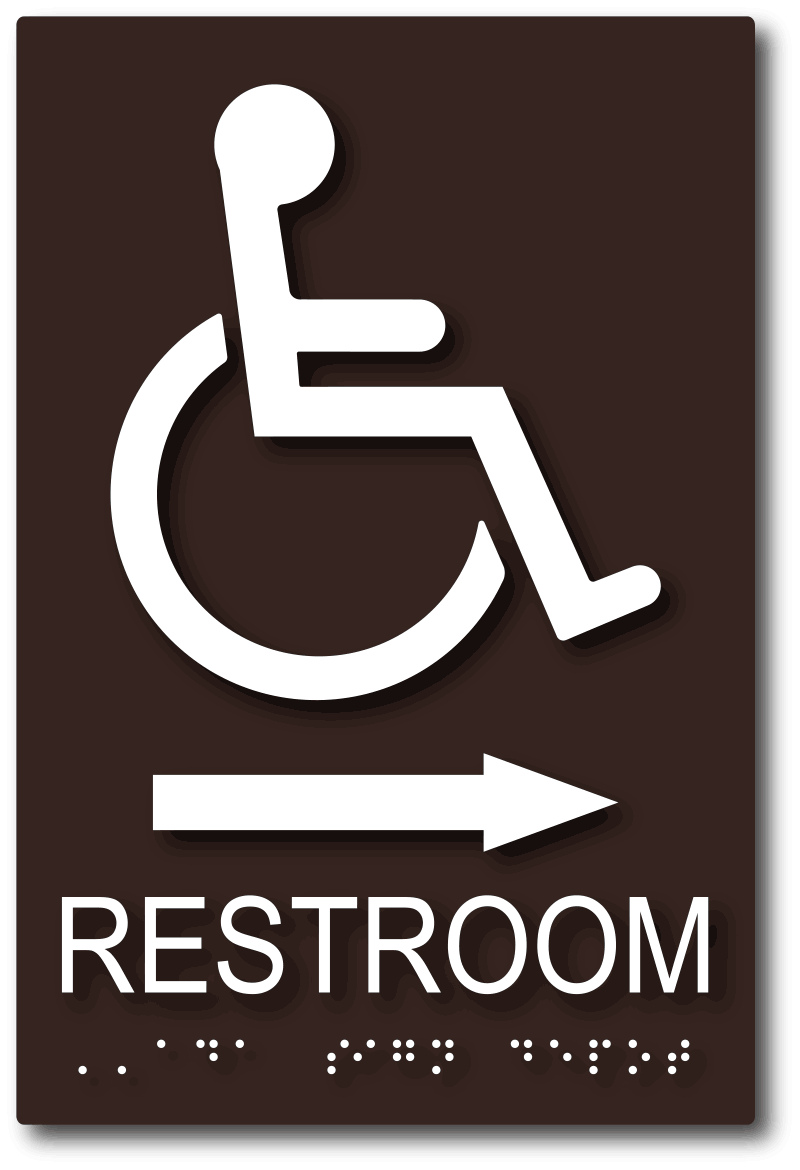ADA Signs: Essential Tools for Inclusive Environments
ADA Signs: Essential Tools for Inclusive Environments
Blog Article
Exploring the Trick Functions of ADA Indicators for Enhanced Accessibility
In the world of availability, ADA signs serve as quiet yet powerful allies, guaranteeing that spaces are accessible and inclusive for people with specials needs. By incorporating Braille and tactile components, these signs break obstacles for the visually impaired, while high-contrast shade schemes and readable fonts provide to varied aesthetic requirements.
Significance of ADA Conformity
Making certain conformity with the Americans with Disabilities Act (ADA) is important for cultivating inclusivity and equal accessibility in public areas and work environments. The ADA, established in 1990, mandates that all public centers, employers, and transportation services fit people with handicaps, ensuring they enjoy the same legal rights and possibilities as others. Conformity with ADA standards not only fulfills lawful commitments but also enhances a company's reputation by demonstrating its commitment to diversity and inclusivity.
One of the essential facets of ADA conformity is the application of available signage. ADA indicators are developed to ensure that people with handicaps can quickly browse with rooms and buildings.
Furthermore, adhering to ADA guidelines can mitigate the danger of potential fines and legal consequences. Organizations that fail to abide by ADA standards might encounter claims or penalties, which can be both economically difficult and harmful to their public image. Therefore, ADA conformity is important to fostering an equitable setting for everyone.
Braille and Tactile Components
The consolidation of Braille and tactile aspects right into ADA signs symbolizes the concepts of accessibility and inclusivity. These features are critical for individuals that are visually damaged or blind, allowing them to browse public spaces with better independence and confidence. Braille, a tactile writing system, is essential in offering written info in a style that can be conveniently regarded via touch. It is usually put under the corresponding text on signage to guarantee that individuals can access the information without visual aid.
Tactile aspects extend past Braille and consist of elevated personalities and signs. These elements are created to be noticeable by touch, enabling people to determine space numbers, toilets, leaves, and various other crucial locations. The ADA establishes specific guidelines regarding the dimension, spacing, and positioning of these tactile aspects to enhance readability and guarantee consistency throughout different atmospheres.

High-Contrast Color Plans
High-contrast color design play a crucial function in boosting the visibility and readability of ADA signs for individuals with aesthetic impairments. These schemes are important as they maximize the distinction in light reflectance in between text and history, guaranteeing that signs are easily noticeable, even from a distance. The Americans with Disabilities Act (ADA) mandates the use of particular color contrasts to suit those with minimal vision, making it an important aspect of compliance.
The efficacy of high-contrast colors click here to read hinges on their ability to stand out in various illumination conditions, including dimly lit environments and locations with informative post glow. Usually, dark text on a light history or light text on a dark background is used to achieve ideal comparison. Black text on a white or yellow background provides a raw visual distinction that assists in quick acknowledgment and understanding.

Legible Fonts and Text Dimension
When considering the style of ADA signage, the choice of legible typefaces and ideal more tips here message dimension can not be overemphasized. The Americans with Disabilities Act (ADA) mandates that font styles should be sans-serif and not italic, oblique, manuscript, very attractive, or of uncommon type.
The size of the message likewise plays an essential role in ease of access. According to ADA standards, the minimal message height should be 5/8 inch, and it needs to boost proportionally with checking out range. This is specifically crucial in public rooms where signage needs to be reviewed rapidly and precisely. Consistency in text dimension adds to a cohesive aesthetic experience, aiding people in browsing settings effectively.
Additionally, spacing between lines and letters is essential to readability. Sufficient spacing prevents characters from showing up crowded, improving readability. By sticking to these requirements, developers can considerably boost availability, guaranteeing that signs serves its designated objective for all individuals, despite their visual abilities.
Reliable Placement Methods
Strategic positioning of ADA signage is necessary for making best use of ease of access and making certain conformity with legal standards. Effectively positioned indications lead individuals with impairments successfully, facilitating navigation in public areas. Trick factors to consider include distance, presence, and elevation. ADA guidelines stipulate that signs should be installed at a height between 48 to 60 inches from the ground to guarantee they are within the line of sight for both standing and seated individuals. This typical elevation array is vital for inclusivity, enabling wheelchair customers and individuals of differing elevations to access details easily.
Additionally, signs need to be placed surrounding to the latch side of doors to permit easy identification prior to entry. Consistency in sign positioning throughout a facility enhances predictability, decreasing confusion and improving general individual experience.

Verdict
ADA indicators play an essential role in advertising access by integrating functions that address the requirements of individuals with handicaps. Including Braille and responsive elements ensures essential info is obtainable to the aesthetically damaged, while high-contrast color design and readable sans-serif typefaces boost exposure throughout various lighting conditions. Efficient positioning methods, such as appropriate installing heights and calculated areas, better promote navigating. These elements collectively promote an inclusive atmosphere, highlighting the significance of ADA compliance in making certain equal gain access to for all.
In the world of accessibility, ADA indicators offer as silent yet powerful allies, ensuring that rooms are navigable and comprehensive for people with specials needs. The ADA, passed in 1990, mandates that all public facilities, employers, and transport solutions accommodate people with handicaps, ensuring they appreciate the very same legal rights and opportunities as others. ADA Signs. ADA indicators are created to ensure that individuals with specials needs can quickly browse with buildings and spaces. ADA standards state that signs ought to be mounted at an elevation between 48 to 60 inches from the ground to ensure they are within the line of view for both standing and seated individuals.ADA indications play an important role in promoting access by integrating functions that attend to the needs of people with specials needs
Report this page